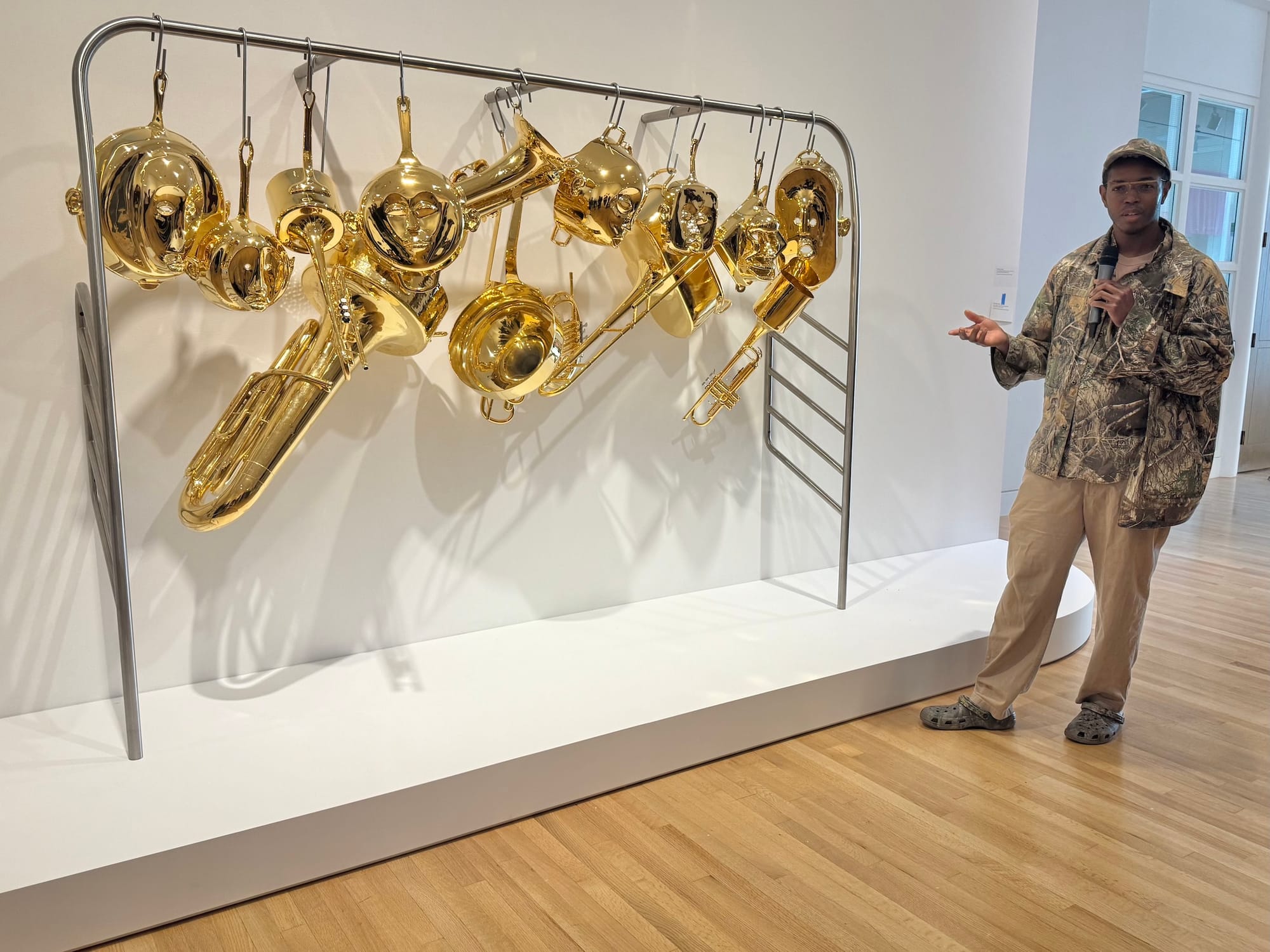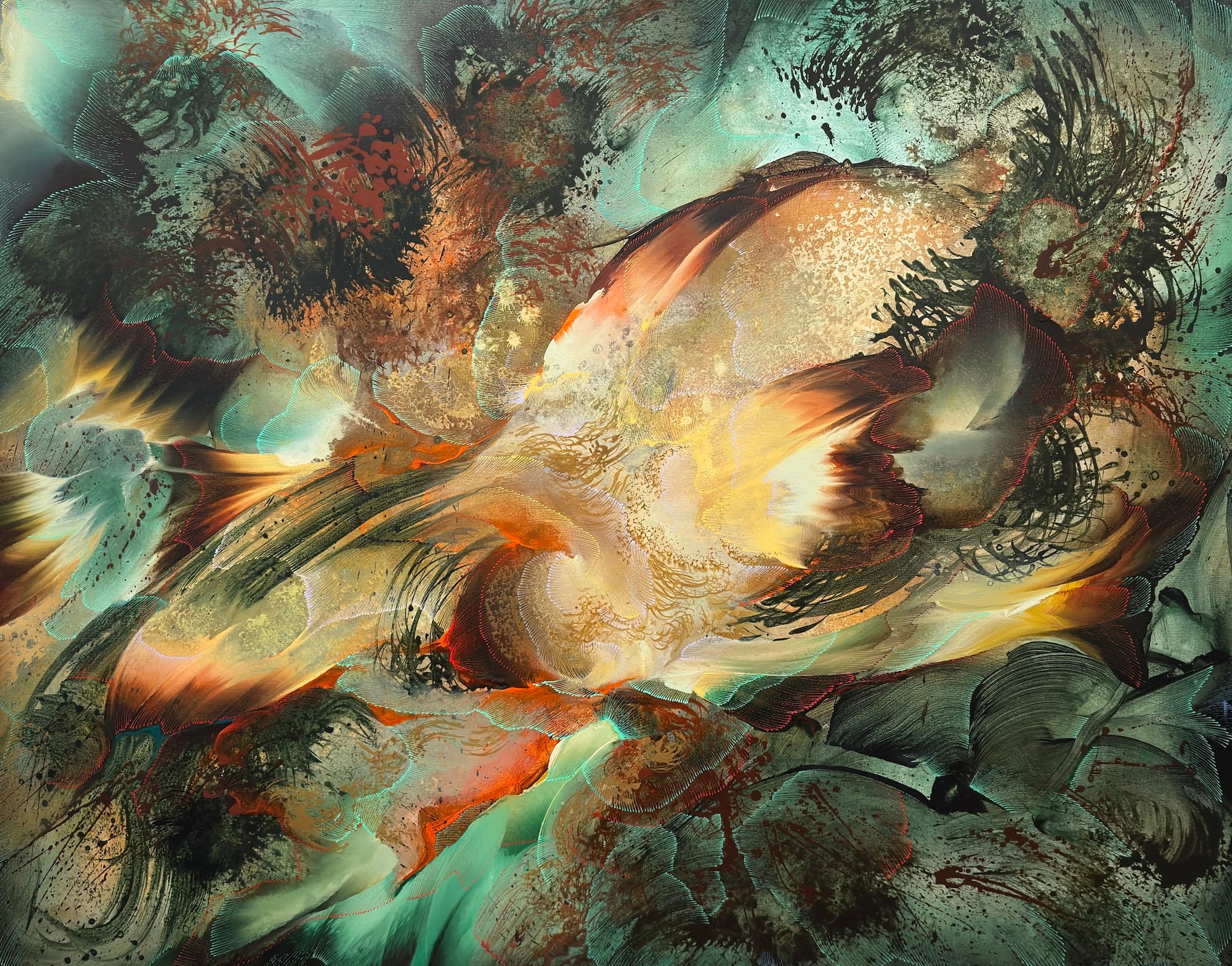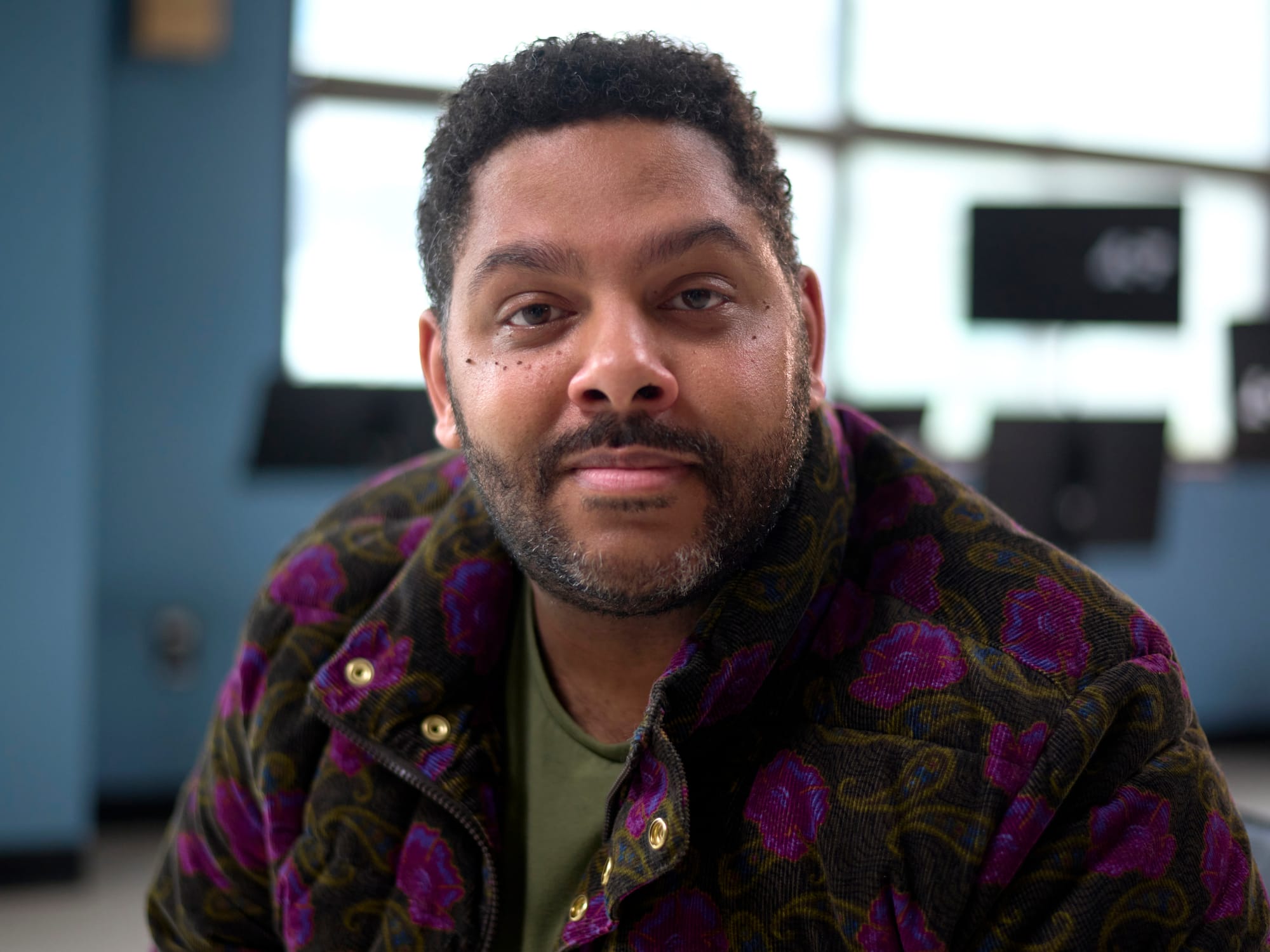In the new show at the Frye Art Museum, one room is laid out like a church. A grove of wooden pews — with curiously upholstered seats — faces a large illuminated sign that flashes red, white and blue. The bulbs are LED emergency lights, arranged in the pattern of an American flag. But the stars and stripes keep shifting … to a cross, a snake eating its own tail and other symbols, as Erykah Badu’s “On & On” plays from a speaker.
Art x NW (formerly ArtSEA) is a weekly arts and culture newsletter from Cascade PBS. Read past issues and subscribe for more.
The sign is so bright it’s painful to look at. (And those pews? Covered in stiff red broom bristles.) In other words, it’s a lot like America. “But people find ways to navigate it,” the artist Hugh Hayden said at the press preview. “And it can be beautiful.”
American Vernacular (through September 28; artist talk July 12 at 3 p.m.) marks Hayden’s first West Coast solo show, and it’s a stunner. Formerly an architect, the Dallas-born, Brooklyn-based artist meticulously crafts work that explores the folklore of the American dream — both its seductiveness and the fact that “it can be challenging to inhabit,” he said.
Take, for example, the Adirondack chair that opens the exhibit. Crafted from fallen hemlock, it invites you to take a seat and relax, perhaps sip iced tea on a porch. Except that the wood slats have sprung alive with jutting and phallic branches. “It suggests pleasure, leisure, home ownership,” Hayden noted, “but it’s nearly impossible to sit in this chair.”
This piece (“The Jones and other borrowed ideas,” 2017) was one of Hayden’s first. It’s staged in an area of the exhibit conceived as “The Lawn,” which also features his most recent work, “Eden.” Here we see a classic white picket fence, the boards of which have branched into a thicket of twisting forms — shovels, rakes, snakes and penises of all colors and sizes.

Humor underlies many of these sculptures, but Hayden says the joke is rooted in the tension of reality — like the comedy, he explained, in seeing someone wipe out on a slippery floor. It’s funny partly because of the danger inherent. And like all successful jokes, they work better when they seem authentic.
Which speaks to the incredible detail and craftsmanship in all of these sculptures — the smooth “bones” in his wooden skeletons, the weave of synthetic hair that transforms a basketball net into a long braid in “Rapunzel.” And in a section called “The Gym,” an array of clothing made from small individual pieces of bark looks like a fairy tale you could step right into.
Hayden — who often dresses in camouflage clothing, and whose glasses have a small twig affixed to the brow — says the bark-covered works are about the desire to blend into American pop culture. For men, that often means getting involved in sports, even when there’s no desire to. Hence the uncomfortable looking football uniform and helmet, both covered in scratchy cherry bark.
Fashion too, is a way of trying to fit in, whether wearing Louboutin stilettos or Timberland boots (both covered in real bark, applied with tweezers). Like so many of Hayden’s works, these sculptures make you hyper-aware of your body, and how it would feel to try to sit on or try on the pieces. Similarly, his series of cast-iron pans, which he re-casts to incorporate molds of African tribal masks, as well as his own ears and nose, imply a weight that you cannot fully put down.
These “melting pots” — a critique of the American cliche, and a comment on the African influence on American food — take on another, exuberant layer when he combines them with brass instruments, then gold-plates the entire amalgam. In “Harlem,” these pot-mask-horns (instruments that could actually still be played, he noted) jangle together on an NYC subway rail, suggesting a joyous clatter.
As he works to turn familiar items into “something uncanny,” Hayden is also working to change the way we think about the rest of the world, including our own dear and puzzling nation.

I’ve heard from several folks who are feeling less than star-spangled about the Fourth of July this year. So for those seeking fireworks of another sort, head to Pioneer Square where you can get your oohs and ahhs by way of the art on view. (Note: First Thursday Art Walk is happening tonight, but many galleries are closed for the holiday on Friday, and some on Saturday too.)
At Chatwin Arts, Color and Line (through Aug. 2) pairs Seattle painters Soo Hong and Kevin Cosley in a dual show of lively abstract vision. Cosley’s large-scale explosions of color swoosh and swirl in turbulent gestures (as he puts it: “color experienced as sensation”), while Hong’s works glisten with a resolute shimmer that swims up through dark hues.
At ArtX Contemporary, Northwest painter William Song presents Draco Arising (though July 26), showcasing oil-based explorations of light and consciousness that play out as celestial spheres and bright bands of gold.
And at nearby J. Rinehart Gallery, Seattle artist Cable Griffith shows Return to Sender (through July 26). Rooted in the deep greens of local nature, these abstracted eco-tableaus are shot through with graphic shapes in neon pinks and purples — and suggest, as he writes, “getting lost on a loop trail.”

Last week we wrapped up Season 4 of Black Arts Legacies — ending strong with Seattle playwright and performer Andrew Lee Creech. I first met Creech when he was premiering his play Last Drive to Dodge, a story based in the 19th-century “golden age” of Black cowboys, at Taproot Theater in 2023.
During our interview back then, I was struck by Creech’s audacious and admirable plan to write a nine-play cycle about significant periods in U.S. history as experienced by Black Americans. Since then, Creech has penned two more plays in his Legacy Plays Project, including Golden (set during the 2008 recession), which premiered at ACT Theatre this past spring.
A serious theater groupie, Creech says, “When we talk about the theater classics that we need to be reading, I would like more Black voices to be in that conversation.”
If you missed any of the other amazing artists featured in this year’s Black Arts Legacies cohort, I encourage you to take a little time this holiday weekend to read and watch our profiles of dancer and choreographer Kisha Vaughan, sculptor and glass artist Henry Jackson-Spieker, jazz drummer and emcee Kassa Overall, and printmaker and installation artist Jite Agbro (whose new show Penumbras runs at Patricia Rovzar Gallery through July 30; artist talk July 12).
All five of this year’s artists reflect the many ways contemporary Black artists are influencing Seattle’s cultural landscape. Not to mention the 50+ additional painters, dancers, musicians, poets, sculptors, actors, DJs, television producers and other artists — past and present — who we’ve profiled in Black Arts Legacies: Seasons 1 - 3! The whole project is a rich, rewarding dive into diverse mediums, and I hope you enjoy the exploration and education.
This issue of Art x NW newsletter is made possible with support from the Seattle Office of Arts and Culture.

Looking for more regional arts coverage? Check out Art by Northwest, a new television series on Cascade PBS, featuring artists from all over Washington.


